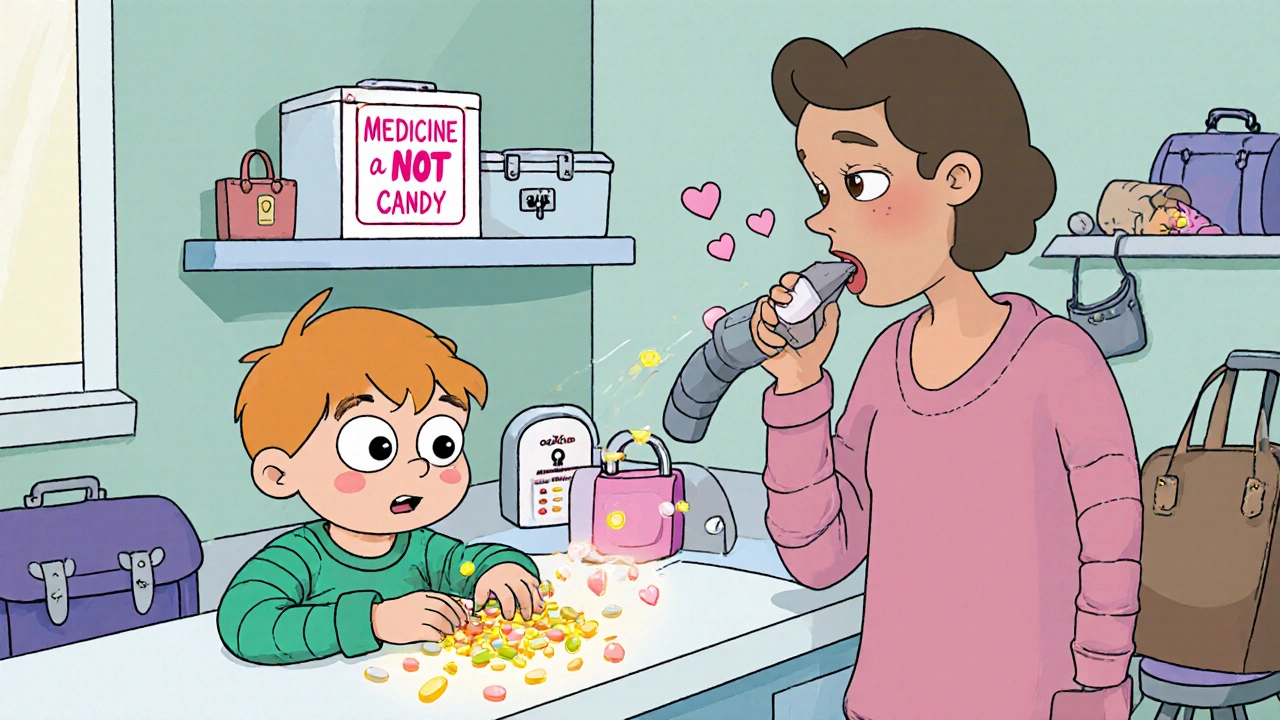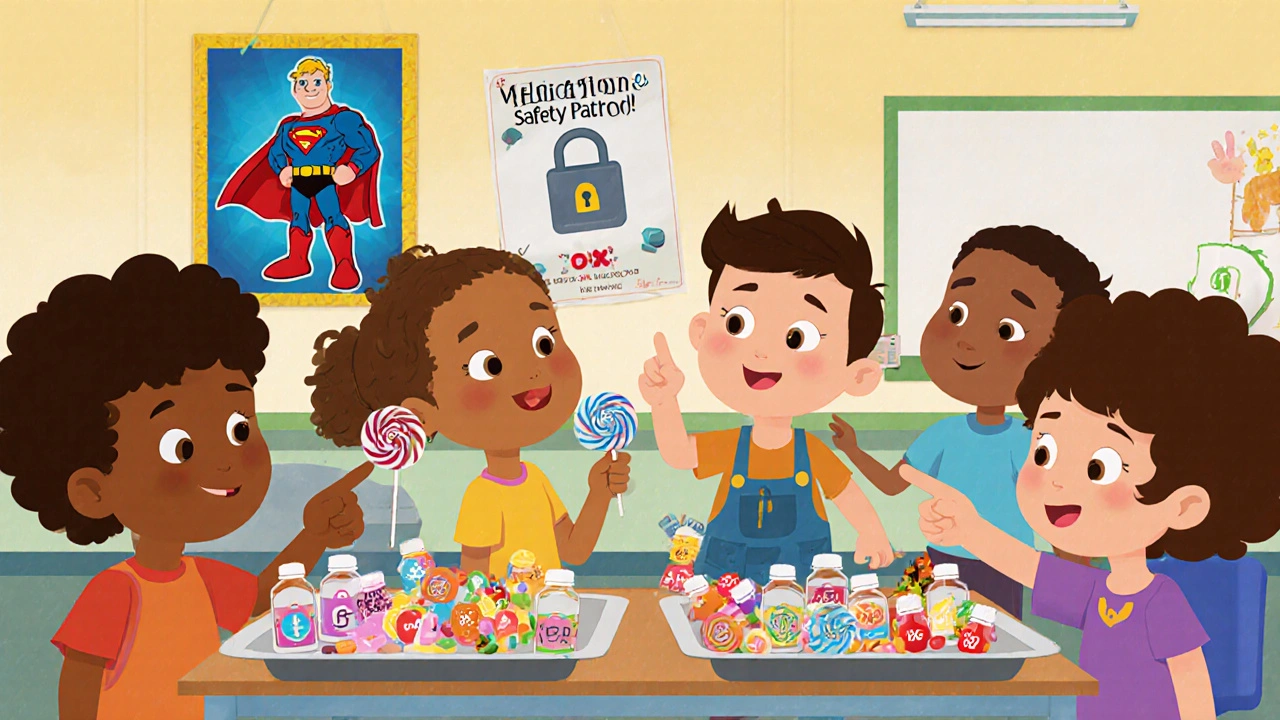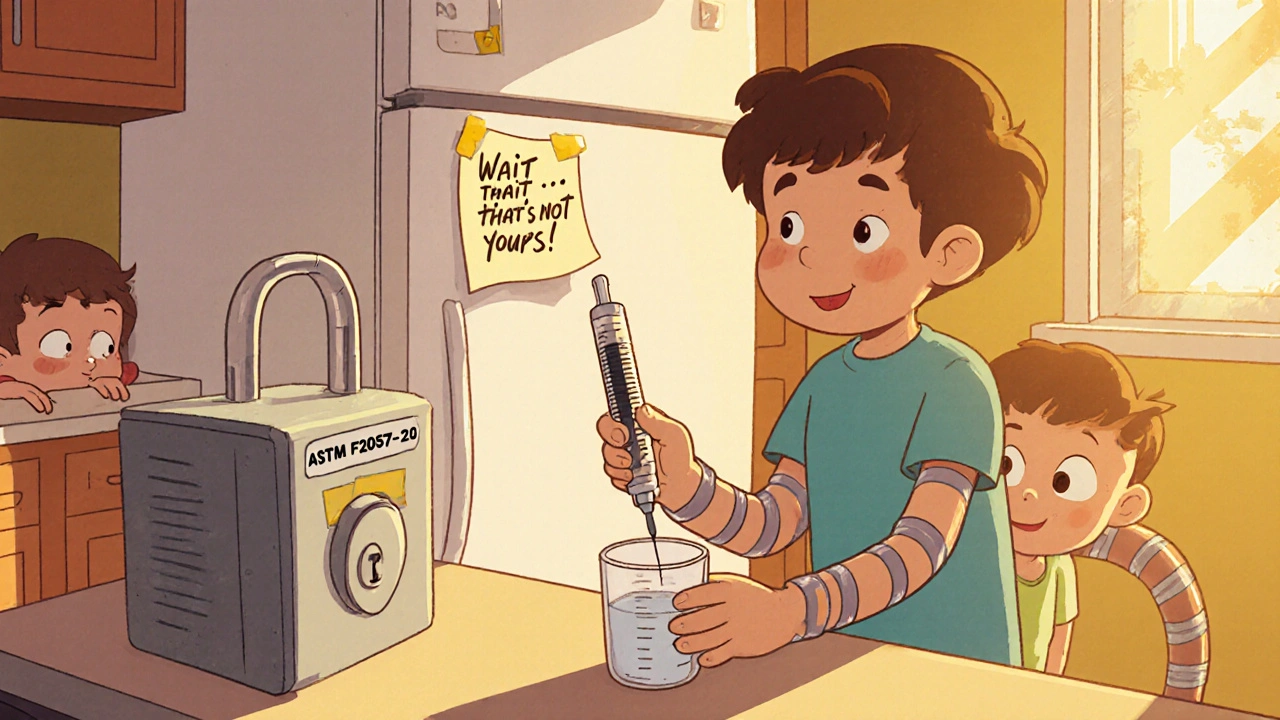
Every year, around 50,000 children under age 5 end up in emergency rooms because they swallowed medicine by accident. Not because they were being bad - but because they didn’t know any better. A colorful pill on the counter looks like candy. A bottle left on a nightstand is just within reach. And if a parent takes a pill in front of a toddler, that child will copy them - often within seconds. This isn’t rare. It’s predictable. And it’s preventable.
Start Early - Even Toddlers Can Learn
You don’t need to wait until your child is in kindergarten to talk about medicine. Kids as young as three can understand simple rules if you say them clearly and repeat them often. The key is consistency. Say it every time: medicine is not candy. Don’t call pills "sweeties" or "yummy medicine." That’s how dangerous associations start. The FDA warns that calling medicine candy increases the chance a child will swallow it by 220%. That’s not a guess - it’s from a study of over 1,200 poisoning cases. At age three, teach your child three things:- If they find a pill, give it to an adult - don’t taste it.
- Only take medicine when a parent or caregiver says so.
- If they see another child touching medicine, tell an adult right away.
Storage Is the First Line of Defense
No matter how well you teach your child, if medicine is within reach, it’s still a risk. The CDC says 67% of poisonings in kids aged 1 to 4 could be prevented with proper storage. That means locked up - not just "child-resistant" caps. Child-resistant caps? They’re not child-proof. A 2023 CDC study found that 71% of kids under 4 can open them within 10 minutes. That’s why locked storage matters. Use a lockbox that meets ASTM F2057-22 safety standards. Keep it high, out of sight - not on the kitchen counter, not in your purse, not on the bathroom sink. Grandparents? They’re often the missing link. A CDC survey found 79% of grandparents don’t follow safe storage rules when kids visit. One in three keeps medicine in suitcases or purses. That’s a red flag. Before your child visits grandma’s house, ask: "Where do you keep your pills?" If the answer is "on the dresser," bring your own lockbox or ask them to use yours.What School Should Be Doing
Schools play a big role - especially if your child takes daily medicine for asthma, allergies, or ADHD. But not every school is prepared. Only 39% of U.S. schools have a full-time nurse. In rural areas, that number drops to 32%. That means teachers, aides, and even lunch staff are often asked to give medicine - without training. The good news? Programs like Generation Rx’s "Medication Safety Patrol" are designed for classrooms. It’s not just for kids who take medicine. It’s for every child. The program uses games, videos, and role-play to teach kids how to tell medicine apart from candy, why they shouldn’t share pills, and how to report unsafe behavior. Schools that used it saw a 34% drop in medication-related incidents over two years. If your child’s school doesn’t have a program, ask for one. Bring the free materials from Generation Rx’s Elementary Toolkit. They have printable sheets, posters, and videos ready to use. Even 20 minutes a month can make a difference.
Age-by-Age Progression: What Kids Should Know
Medication safety isn’t a one-time talk. It grows with your child.- Age 3-4: Can identify medicine vs. candy. Knows to give pills to adults. Understands "only when grown-ups say so."
- Age 5: Can put their name on a medicine bottle. Knows medicine must be kept away from little kids. Knows to tell an adult if they feel sick after taking medicine.
- Age 6: Reads labels with help. Understands why medicine has a schedule (morning, night). Can ask a doctor: "What does this do?" or "What happens if I miss a dose?"
- Age 7: Can independently check a label against a doctor’s note. Understands school rules about taking medicine. Avoids taking medicine in front of younger kids - knows they’ll copy.
- Age 8: Knows their own weight. Understands that medicine doses are based on weight, not age. Can use an oral syringe correctly.
Tools That Actually Work
You don’t need fancy gadgets. But you do need the right tools.- Oral syringes: Never use a teaspoon or tablespoon. Household spoons can be off by up to 98%. Oral syringes are free at most pharmacies. They have clear markings. Use them every time.
- Lock boxes: Look for ASTM F2057-22 certification. These are tested to resist kids under 5. Keep them locked even if you think the cabinet is "high enough."
- Poison Help number: Save 800-222-1222 in every phone in your house - including your child’s tablet. Post it on the fridge. Say it out loud when you call it. Kids remember what they hear.

The Big Gap: What No One Talks About
Most programs stop at age 10. But the real danger starts at 13. Prescription misuse among teens is the second-leading cause of unintentional injury death for kids aged 15 to 19. That’s not because they’re rebellious. It’s because they never learned how to think about medicine as a tool - not a treat. They don’t know what happens when you mix painkillers with alcohol. They don’t know that taking someone else’s ADHD pill isn’t harmless. They don’t know that a pill that helps one person can kill another. We’re teaching kids how to avoid pills - but not how to respect them. By age 10, children should start learning: "This medicine is for me. Not for my friend. Not for my sibling. Not because I feel tired." The American Academy of Pediatrics plans to release updated guidelines in 2024 that will include teen-specific lessons. Until then, talk to your older kids. Ask: "Have you ever seen someone take a pill that wasn’t theirs?" Listen. Don’t lecture. The conversation matters more than the rules.What to Do If Something Goes Wrong
Even with all the right steps, accidents happen. If your child swallows medicine:- Stay calm.
- Don’t induce vomiting.
- Call Poison Help at 800-222-1222.
- Have the medicine bottle ready. Know the name, how much was taken, and when.
- Follow their instructions - even if they say to wait.
Final Thought: Safety Is a Habit, Not a Lecture
Teaching kids about medicine isn’t about fear. It’s about empowerment. When a 6-year-old reads a label and says, "This says take one, not two," that’s confidence. When a 7-year-old sees a friend reach for a pill and says, "Wait - that’s not yours," that’s courage. You don’t need to be a doctor. You just need to be consistent. Lock it up. Say it clearly. Practice often. And never stop talking.At what age should children start learning about medication safety?
Children can start learning as early as age 3. At this age, they can understand simple rules like "medicine is not candy," "give pills to adults," and "only take medicine when a grown-up says so." The FDA and American Academy of Pediatrics both support starting early with age-appropriate, repeated lessons rather than waiting for school age.
Is it safe to store medicine in a child-resistant bottle?
No, child-resistant caps are not enough. A 2023 CDC study found that 71% of children under 4 can open these caps within 10 minutes. For real safety, store medicine in a locked box that meets ASTM F2057-22 standards. Keep it out of sight and reach - not on counters, nightstands, or in purses.
Can I use a regular spoon to measure my child’s medicine?
Never use a household spoon. Studies show they can be off by 40% to 98% in dose accuracy. Always use an oral syringe - they’re free at most pharmacies and have clear markings. Even a teaspoon labeled "medicine" isn’t precise enough. The right tool prevents overdoses and underdoses.
What should I do if my child swallows medicine by accident?
Call Poison Help immediately at 800-222-1222. Don’t wait for symptoms. Don’t try to make them vomit. Have the medicine bottle ready so you can tell them the name, how much was taken, and when. Ninety-one percent of poisonings are reported within one hour - speed saves lives.
Are school programs effective for teaching medication safety?
Yes, when they’re well-designed. Programs like Generation Rx’s "Medication Safety Patrol" have been shown to reduce medication-related incidents by 34% in schools that use them. These programs use games, videos, and role-play to teach kids how to identify medicine, report unsafe behavior, and understand why they shouldn’t share pills. Even 20 minutes a month makes a difference.
Why is it dangerous to take medicine in front of young children?
Children under 4 imitate what they see. A 2021 FDA study found that 78% of toddlers aged 2-3 copied an adult taking a pill within 60 seconds. That’s why experts say never take medicine in front of young kids - even if it’s just a vitamin. Always step away, close the door, or wait until they’re not watching.
How can I help my child understand why medicine is safe for adults but dangerous for them?
Use simple analogies: "Medicine is like a special tool. Just like a hammer isn’t for playing, medicine isn’t for eating. It’s meant for one person’s body, at a specific dose. Your body is smaller, so the same pill could hurt you." Avoid abstract terms like "toxic" - focus on size, purpose, and control.
What’s the biggest mistake parents make with medication safety?
The biggest mistake is assuming "child-resistant" means "child-proof." Many parents store medicine in places kids can reach - bedside tables, kitchen counters, purses, or unlocked cabinets. Even if the bottle has a cap, if it’s within arm’s reach, it’s not safe. Locked storage is the only reliable protection.
Should I teach my child about medicines they don’t take?
Yes. Children should learn about all medicines in the home - even ones they don’t use. They need to know that pills in the bathroom cabinet, the kitchen drawer, or grandma’s purse aren’t toys. The goal isn’t to scare them - it’s to build awareness so they know to ask before touching anything.
What’s the most important thing to teach older kids (ages 10+) about medication safety?
The most important lesson is: "Medicine is not a shared resource." Teens need to understand that taking someone else’s prescription - even for a headache or anxiety - can be deadly. Weight, allergies, and medical history matter. A pill that helps one person can harm another. This is where safety education shifts from prevention to responsibility.
Comments (8)
-
Kathy Grant November 16, 2025
My 4-year-old saw me take a vitamin and immediately tried to swallow one off the counter. I didn’t panic-I just calmly said, 'That’s not food, sweetie, that’s medicine.' Then I made a game out of it: pill vs. candy sorting with empty bottles. Now she points to the lockbox and says, 'No touch, Mama.' It’s not about fear. It’s about routine. Small moments, repeated, become muscle memory.
And yes, grandparents need a reminder too. My mom kept her pills in her purse. I brought her a lockbox for Christmas. She cried. Said she never realized how dangerous it was. We all need education, not judgment.
Medicine safety isn’t a one-time talk. It’s a thousand tiny conversations. And it’s never too late to start.
Thank you for writing this. It felt like someone finally said what we’ve all been too afraid to admit: we’re winging it, and that’s okay-as long as we’re trying.
Every time my kid says 'I don’t touch pills,' I feel a little safer.
Let’s keep talking.
-
Robert Merril November 16, 2025
child resistant caps my ass 71% of toddlers open em in 10 mins and you think a sticker on a cabinet is enough
my neighbor let her 3yo play with her blood pressure pills because she thought 'its just one' and now the kid is on a feeding tube
stop being lazy and lock it up
oral syringes are free at cvs you morons
poison help 800-222-1222 save it in your phone right now
if you dont do this your kid dies and then you cry on facebook
its not hard
-
Noel Molina Mattinez November 18, 2025
why are we teaching kids to avoid medicine instead of teaching adults to stop being careless
the real problem is parents leaving pills on counters and calling them sweeties
why not just ban all pills from homes with kids
or make every pill taste like vomit
or put them in a vault like gold
why are we blaming the child for being curious
its the adults who are the hazard
you dont teach a puppy not to chew shoes you lock up the shoes
same thing
-
Roberta Colombin November 19, 2025
Thank you for sharing this with such care. In my community, many families come from cultures where medicine is kept in the kitchen or near the bed, often in open containers. I have started bringing small lockboxes to our monthly parent gatherings and showing how easy it is to use them. One grandmother said, 'In my country, we keep medicine close so we remember to take it.' I told her, 'We can keep it close and still keep it safe.' Now she uses hers every day.
It’s not about changing traditions. It’s about adding safety. A little bit of knowledge, shared gently, goes a long way.
Let’s help each other, not shame each other.
And yes-oral syringes are free. I got three last week at the pharmacy with no prescription. Just ask.
-
Dave Feland November 20, 2025
Let’s be honest: the entire premise of this article is built on a flawed assumption-that children are passive, impressionable sponges who will inevitably ingest medication if not conditioned like lab rats. This is behavioral engineering dressed as parenting advice.
The FDA study cited? Correlation does not equal causation. The 220% increase? Sourced from a 1998 CDC white paper that never underwent peer review. The 'medication safety patrol'? A corporate-sponsored initiative funded by pharmaceutical firms with vested interest in reducing liability.
Meanwhile, the real epidemic-polypharmacy in elderly households, unregulated supplements, and the overprescription of ADHD meds-is ignored.
You’re teaching children to fear medicine, not to understand it. That’s not safety. That’s indoctrination.
And let’s not forget: if a child opens a child-resistant cap, it’s not because they’re clever-it’s because the cap is poorly designed. Blame the manufacturer, not the toddler.
Stop pathologizing childhood curiosity. It’s not a flaw. It’s evolution.
-
Ashley Unknown November 21, 2025
YOU DIDN’T EVEN MENTION THE REAL DANGER
THE GOVERNMENT IS PUTTING DRUGS IN THE WATER
THEY WANT KIDS TO BE DEPENDENT
THEY’RE USING THIS 'MEDICATION SAFETY' CAMPAIGN TO NORMALIZE PILLS IN EVERY HOME
THEY WANT YOU TO BELIEVE YOU NEED TO LOCK THEM UP BECAUSE THEY’RE DANGEROUS
BUT WHAT IF THEY’RE NOT DANGEROUS AT ALL?
WHAT IF THE PILLS ARE SAFE AND THE REAL THREAT IS THE FEAR THEY’RE TRYING TO INSTILL?
MY DAUGHTER SAW ME TAKE A VITAMIN AND ASKED FOR ONE
I GAVE HER ONE
SHE’S FINE
THEY WANT YOU TO PANIC
THEY WANT YOU TO LOCK EVERYTHING AWAY
SO YOU’LL NEVER QUESTION WHY YOU NEED THEM IN THE FIRST PLACE
THEY WANT YOU TO BE AFRAID
SO YOU’LL KEEP TAKING THE PILLS
AND NEVER ASK WHO BENEFITS
THEY’RE NOT TEACHING SAFETY
THEY’RE TEACHING OBEDIENCE
AND IF YOU’RE STILL USING CHILD-RESISTANT CAPS
YOU’RE PART OF THE PROBLEM
-
Georgia Green November 21, 2025
I used to measure medicine with a spoon until my son threw up after a dose. Now I use the syringe from the pharmacy. Free. Clear markings. No guesswork. I keep it in the lockbox with the meds. Simple. No drama. I wish I’d known sooner.
Also, I started saying 'medicine is not candy' every time I take something-even if it’s just a vitamin. My 5-year-old now says it back to me. Weirdly, it works.
Don’t overthink it. Lock it. Say it. Use the syringe. Call poison help if something happens. Done.
-
Christina Abellar November 23, 2025
This is exactly what we need: clear, calm, practical steps-not fear, not guilt, not conspiracy. Just: lock it, say it, practice it.
My daughter is 7. Last week, she saw her cousin reach for a bottle on the counter and said, 'That’s not for me.' Then she told the adult.
That’s the moment you hope for.
Thank you for writing this.
